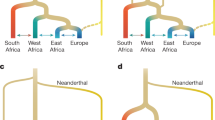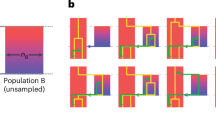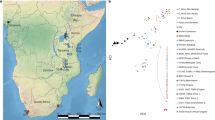Abstract
Investigating how an ancestral population diverges to give rise to distinct subpopulations remains a fundamental pursuit in population genetics. There is broad consensus for the ‘Out-of-Africa’ hypothesis that states that modern humans arose ∼200 000 years ago in Africa and spread throughout the continent ∼100 000 years ago. This was followed by several waves of major population dispersals across the globe, although the exact nature of the population divergence remains debatable. Existing methods to estimate population divergence time differ in their methodological frameworks and demographic assumptions, and require different types of genetic data as input. These fundamental differences often result in the methods producing inconsistent estimates of the population divergence time, further confounding attempts to robustly uncover the history of human migration, especially when most population genetic studies do not employ multiple methods to estimate the time to the most recent common ancestor (TMRCA). Here, we chose eight popular methods for estimating TMRCA and evaluated their robustness and accuracy in correctly identifying the true TMRCA through a series of simulations that mimicked different evolutionary scenarios. We subsequently applied all eight methods to estimate the population divergence time between Southeast Asian Malays and South Asian Indians using deep whole-genome sequencing data.
Similar content being viewed by others
Log in or create a free account to read this content
Gain free access to this article, as well as selected content from this journal and more on nature.com
or
References
Mellars P : A new radiocarbon revolution and the dispersal of modern humans in Eurasia. Nature 2006; 439: 931–935.
Cann RL, Stoneking M, Wilson AC : Mitochondrial DNA and human evolution. Nature 1987; 325: 31–36.
Peng B, Amos CI, Kimmel M : Forward-time simulations of human populations with complex diseases. PLoS Genet 2007; 3: e47.
Ewens WJ : Mathematical Population Genetics, 2nd edn New York: Springer, 2004.
Vigilant L, Stoneking M, Harpending H, Hawkes K, Wilson AC : African populations and the evolution of human mitochondrial DNA. Science 1991; 253: 1503–1507.
Prufer K, Racimo F, Patterson N et al: The complete genome sequence of a Neanderthal from the Altai Mountains. Nature 2014; 505: 43–49.
Macaulay V, Hill C, Achilli A et al: Single, rapid coastal settlement of Asia revealed by analysis of complete mitochondrial genomes. Science 2005; 308: 1034–1036.
Rasmussen M, Guo X, Wang Y et al: An Aboriginal Australian genome reveals separate human dispersals into Asia. Science 2011; 334: 94–98.
Pinhasi R, Thomas MG, Hofreiter M, Currat M, Burger J : The genetic history of Europeans. Trends Genet 2012; 28: 496–505.
Reich D, Patterson N, Campbell D et al: Reconstructing Native American population history. Nature 2012; 488: 370–374.
Kingman JF : Origins of the coalescent. 1974-1982. Genetics 2000; 156: 1461–1463.
Tavare S, Balding DJ, Griffiths RC, Donnelly P : Inferring coalescence times from DNA sequence data. Genetics 1997; 145: 505–518.
Donnelly P, Tavare S : Coalescents and genealogical structure under neutrality. Annu Rev Genet 1995; 29: 401–421.
Becquet C, Przeworski M : A new approach to estimate parameters of speciation models with application to apes. Genome Res 2007; 17: 1505–1519.
Hobolth A, Christensen OF, Mailund T, Schierup MH : Genomic relationships and speciation times of human, chimpanzee, and gorilla inferred from a coalescent hidden Markov model. PLoS Genet 2007; 3: e7.
Gronau I, Hubisz MJ, Gulko B, Danko CG, Siepel A : Bayesian inference of ancient human demography from individual genome sequences. Nat Genet 2011; 43: 1031–1034.
Mailund T, Dutheil JY, Hobolth A, Lunter G, Schierup MH : Estimating divergence time and ancestral effective population size of Bornean and Sumatran orangutan subspecies using a coalescent hidden Markov model. PLoS Genet 2011; 7: e1001319.
Li H, Durbin R : Inference of human population history from individual whole-genome sequences. Nature 2011; 475: 493–496.
Schiffels S, Durbin R : Inferring human population size and separation history from multiple genome sequences. Nat Genet 2014; 46: 919–925.
Hayes BJ, Visscher PM, McPartlan HC, Goddard ME : Novel multilocus measure of linkage disequilibrium to estimate past effective population size. Genome Res 2003; 13: 635–643.
de Roos AP, Hayes BJ, Spelman RJ, Goddard ME : Linkage disequilibrium and persistence of phase in Holstein-Friesian, Jersey and Angus cattle. Genetics 2008; 179: 1503–1512.
McEvoy BP, Powell JE, Goddard ME, Visscher PM : Human population dispersal ‘Out of Africa’ estimated from linkage disequilibrium and allele frequencies of SNPs. Genome Res 2011; 21: 821–829.
Gutenkunst RN, Hernandez RD, Williamson SH, Bustamante CD : Inferring the joint demographic history of multiple populations from multidimensional SNP frequency data. PLoS Genet 2009; 5: e1000695.
Reich DE, Cargill M, Bolk S et al: Linkage disequilibrium in the human genome. Nature 2001; 411: 199–204.
Marth GT, Czabarka E, Murvai J, Sherry ST : The allele frequency spectrum in genome-wide human variation data reveals signals of differential demographic history in three large world populations. Genetics 2004; 166: 351–372.
Plagnol V, Wall JD : Possible ancestral structure in human populations. PLoS Genet 2006; 2: e105.
Hudson RR : Generating samples under a Wright-Fisher neutral model of genetic variation. Bioinformatics 2002; 18: 337–338.
Scally A, Durbin R : Revising the human mutation rate: implications for understanding human evolution. Nat Rev Genet 2012; 13: 745–753.
Ho SY, Lanfear R, Bromham L et al: Time-dependent rates of molecular evolution. Mol Ecol 2011; 20: 3087–3101.
Acknowledgements
Y-YT acknowledges support from the Saw Swee Hock School of Public Health and Life Sciences Institute from the National University of Singapore and also from the National Research Foundation Singapore (NRF-RF-2010-05).
Author information
Authors and Affiliations
Corresponding author
Ethics declarations
Competing interests
The authors declare no conflict of interest.
Additional information
Supplementary Information accompanies this paper on European Journal of Human Genetics website
Supplementary information
Rights and permissions
About this article
Cite this article
Zhou, J., Teo, YY. Estimating time to the most recent common ancestor (TMRCA): comparison and application of eight methods. Eur J Hum Genet 24, 1195–1201 (2016). https://doi.org/10.1038/ejhg.2015.258
Received:
Revised:
Accepted:
Published:
Issue date:
DOI: https://doi.org/10.1038/ejhg.2015.258



